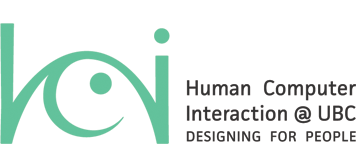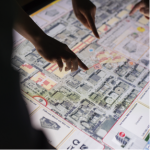
April 13 Forum
Third annual end-of-the-year Demo and Poster Festival

showcasing some of the great HCI research underway at UBC
When: 12-2PM (extended time)
Where: CIRS BC Hydro Theatre (different location)
Summary
Selected demos and posters drawn from the broad range of HCI research underway at UBC will be showcased. Join us for an opportunity to see up close and personal what is happening and meet the people who are doing it. Light, reception-style food and beverage will be served to promote casual networking.
Submit a poster or demo. Send a title, abstract, and the names of presenters for your poster or demo. Posters should have a maximum width of 4 feet. Demos will have use of one table and access to power and wireless (no other equipment provided, bring an extension cord if you need one). Deadline for submission is April 6. Send submissions by email to Dr. Narges Mahyar <nmahyar@cs.ubc.ca>.
Posters can be new work, or they can be posters presented earlier this year at conferences or other events. The goal is to provide a forum for UBC researchers interested in HCI to share their work with local colleagues by recycling presentations made at non-UBC venues. Demos can be anything that shows off recent work or work-in-progress done at UBC.
Prizes will be awarded for the best posters and demos based on votes from those attending. Impress your colleagues by submitting an award-winning poster or demo for this once-a-year event.
Location and time
April 13, 2016
EDC Design Studio (Room 102)
Noon-1pm
March 16 Forum
Haptic cooperation among multiple networked users
 Prof. Daniela Constantinescu
Prof. Daniela Constantinescu
Daniela Constantinescu leads the Assistive Robotics and Mechatronics Laboratory at the University of Victoria, Canada. Her research interests are in haptics, robotics and mechatronics. Her haptics work focuses on guaranteed stable and physically realistic haptic rendering and control in arbitrary virtual environments. She has developed rigid contact modeling techniques to improve the perceived rigidity of virtual contacts and the stability of haptic simulations, and impulse-based control methods to render virtual constraints for rehabilitation and to render the manipulation of virtual linkages. Current work focuses on force-based cooperation among multiple users connected across computer networks.
This lecture is sponsored in part by the Patrick Campbell Chair in Mechanical Engineering Design
Abstract
The Internet supports numerous interactions in digital space, including sharing information, meeting people, participating in online communities. Notably absent is the support for haptic (force and/or touch) interactions. In this talk, I present a control framework which supports force interactions among multiple distant users across communications with limited throughput and unreliable. The framework connects the remote users through a passivity-based coordination controller, and proposes energy management strategies to reduce the conservatism of passivity-based control and to increase performance. The coordination, be it centralized or distributed, uses filtered wave communications. The energy management strategies take advantage of the separation between the perception band and the action band of operators. The centralized coordination controller is robust to arbitrarily large network delays and renders virtual contacts that are an order of magnitude stiffer than the contacts rendered by other centralized controllers, and that are as stiff as the contacts rendered by conventional distributed controllers. The distributed coordination controller is n-port passive and, thus, can be designed independent of the virtual environment. Experimental validation is carried out on a testbed with up to four cooperating users.
Location and time
March 16, 2016
EDC Design Studio (Room 102)
Noon-1pm
February 10 Forum
Why Vis Is(n’t) HCI

Miriah Meyer. Photo: Ryan Lash
Prof. Miriah Meyer
Miriah is a USTAR assistant professor in the School of Computing at the University of Utah and a faculty member in the Scientific Computing and Imaging Institute. Her research focuses on the design of visualization systems for helping researchers make sense of complex data. She obtained her bachelors degree in astronomy and astrophysics at Penn State University, and earned a PhD in computer science from the University of Utah. Prior to joining the faculty at Utah Miriah was a postdoctoral research fellow at Harvard University and a visiting scientist at the Broad Institute of MIT and Harvard.
Miriah is the recipient of a NSF CAREER grant, a Microsoft Research Faculty Fellowship, and a NSF/CRA Computing Innovation Fellow award. She was named both a TED Fellow and a PopTech Science Fellow, as well as included on MIT Technology Review’s TR35 list of the top young innovators and Fast Company’s list of the 100 most creative people. She was also awarded an AAAS Mass Media Fellowship that landed her a stint as a science writer for the Chicago Tribune.
Abstract
Visualization design shares many commonalities with HCI practice: a commitment to understanding the technological needs of people, a primacy of evaluation with users, and an embrace of the iterative nature of design. And yet, creating a visualization artifact is fundamentally different than that for HCI. In this talk I’ll explore several core aspects of the visualization design process — task analysis, evaluation, and rapid prototyping — and discuss what is unique about each. Spoiler alert: it all comes down to data.
Location and time
February 10, 2016
EDC Design Studio (Room 102)
Noon-1pm
January 13 Forum
Unubiquitous Computing: Critiquing Human Computer Interaction Through Critical Making
 Prof. Garnet Hertz
Prof. Garnet Hertz
Dr. Garnet Hertz is Canada Research Chair in Design and Media Arts and is Associate Professor in the Faculty of Design and Dynamic Media at Emily Carr. His research explores DIY culture, electronic art and critical design practices. He has shown his work at several notable international venues in seventeen countries including SIGGRAPH, Ars Electronica, and DEAF and was awarded the 2008 Oscar Signorini Award in robotic art. Hertz is founder and director of Dorkbot SoCal, a monthly Los Angeles-based lecture series on DIY culture, electronic art and design. He has worked at Art Center College of Design and University of California Irvine. His research is widely cited in academic publications, and popular press on his work has disseminated through 25 countries including The New York Times, Wired, The Washington Post, NPR, USA Today, NBC, CBS, TV Tokyo and CNN Headline News. More info: http://conceptlab.com/
Abstract
New communication technologies have contributed to the rise of interpersonal interconnections, but have at the same time led to the public feeling overloaded with pervasive information technologies. Hertz outlines his recent work as Canada Research Chair in Design and Media Art, currently focused on building fully functional technical objects that both highlight this problem and offer imaginative solutions to improve Human Computer Interaction (HCI). Hertz is also working to deliver a clearly articulated framework for the process of integrating creative technologies as an alternate mode of knowledge dissemination, titled ‘critical making’.
Location and time
January 13, 2016
EDC Design Studio (Room 102)
Noon-1pm
December 9 Forum
Designing a Brain-Tablet App to Help Children Living in Poverty
 Prof. Alissa Antle
Prof. Alissa Antle
Dr. Antle is a Professor in the School of Interactive Arts + Technology at Simon Fraser University, Canada. Dr. Antle holds Bachelor degrees in Systems Design Engineering and Liberal Arts from the University of Waterloo and a Ph.D. from the University of British Columbia. After her graduate studies, Dr. Antle spent eight years in the new media industry working as a senior designer and executive producer for children’s new media and television companies. Her academic research focuses on embodied and child human-computer interaction and proceeds through the design and evaluation of tangible and tabletop computing applications and interactive environments. She led the GRAND research group on HCI for children, won a European DEVICE award for best design tool for vulnerable populations, received an ACM Computing Reviews notable paper for her work on metaphor theory in design, and recently has been nominated to the Royal Society of Canada’s College of New Scholars, Artists and Scientists for outstanding early career achievement. In her spare time, Alissa hangs out on a remote island with her two teenage sons and two sock-eating Labrador Retrievers — enjoying a world without email, cell phones or traffic jams.
Abstract
How can we provide education for some of the world’s poorest children? Even with access to education many children are unable to focus on learning due to the multiple traumas they have suffered: poverty, parental mental illness and addictions, homelessness and civil war. Dr. Antle will talk about her recent trips to Nepal where she found a need for a brain-computer interface in the most unlikeliest of places – an NGO-funded school that works with vulnerable children. You’ll hear how new interactive technologies have enabled Dr. Antle to design a brain-tablet app has helped these children succeed at school by providing a modern take on the ancient practice of meditation.
Location and time
December 9, 2015
EDC Design Studio (Room 102)
Noon-1pm
November 18 Forum
Designing a New Medication Management Module for a Primary Care EMR
 Dr. Morgan Price
Dr. Morgan Price
MORGAN PRICE, MD, PhD, CCFP, FCFP is an assistant professor (University of British Columbia, Department of Family Practice) and family physician practicing in the inner city with under-served populations. Dr. Price is an Adjunct Professor in Computer Science and Health Information Science at the University of Victoria. His area of interest is in design and adoption research of clinical information systems, focused in primary care, decision support, and consumer oriented information systems (Personal Health Records).
Abstract
:
This talk describes a design research study that engaged physicians and pharmacists to come up with features for a primary care electronic medical record’s (EMR) medication management module. The talk will describe the process and Lead User Method and share some key findings on what users wanted to achieve and how they might want to achieve them using an EMR.
Location and time
November 18, 2015
EDC Design Studio (Room 102)
Noon-1pm
October 14 Forum
Boy or Bot?: Accounting for Social Agents in Future Social Computing Systems
Prof. David McDonald
Dr. David W. McDonald is Professor and Chair of the Department of Human Centered Design & Engineering (HCDE) in the College of Engineering at University of Washington. Dr. McDonald’s research focuses on the design and implementation of systems that support large-scale collaboration. He has published research on ubiquitous sensing for behavior change, collaboration in distributed contributor systems, collaborative authoring, recommendation systems, and public use of large screen displays. His research interests span Social Computing, Computer-Supported Cooperative Work (CSCW) and Human-Computer Interaction (HCI). Dr. McDonald earned his Ph.D. in Information and Computer Science at the University of California, Irvine. At UC Irvine he was part of the Computing, Organizations, Policy and Society (CORPS) group. He worked at FX Palo Alto Laboratory in the Personal and Mobile technology group and at AT&T Labs in the Human Computer Interaction group. Dr. McDonald served as a Program Officer for the Human Centered Computing (HCC), Network Science and Engineering (NetSE), and Social Computational Systems (SoCS) programs at the National Science Foundation (NSF).
Abstract
On June 8th 2014, the popular press reported that an Artificial Intelligence (AI) had finally passed the Turing test. The growing sophistication of social bots or social agents presents a number of challenges to social computing. A challenge for analysts: How can we know if the behavioral traces, the wikipedia edits, the message board posts, the tweets, or even instagram photos, were produced by a real person with real human motivations, or whether the motivations were provided by the code of a programmer? A challenge for system designers: As social computing systems grow up, we should naturally expect that ever more sophisticated social bots will take their place in the milieu of people and code that interact online. This talk considers the findings from the study of one social botnet that lived on twitter for about 32 weeks. The findings help us understand one simple social botnet, how it compares to regular people, and how it may have influenced discussions. These findings provide an anchor for considering how the design of future social computing systems should account for increasing participation from social agents.
Location and time
October 14, 2015
EDC Design Studio (Room 102)
Noon-1pm
September 9 Forum
Third Annual Kickoff Event
You will be treated to short talks that show the breadth of HCI-related research and activities happening at UBC.
Kellogg Booth – Welcome and update on the HCI@UBC Sub-specialization
Professor, Department of Computer Science
Elizabeth Dunn – Social Cognition and Emotion
Professor, Department of Psychology
Giuseppe Carenini – Intelligent Interfaces
Associate Professor, Department of Computer Science
Location and time
September 9, 2015
EDC Design Studio (Room 102)
Noon-1pm